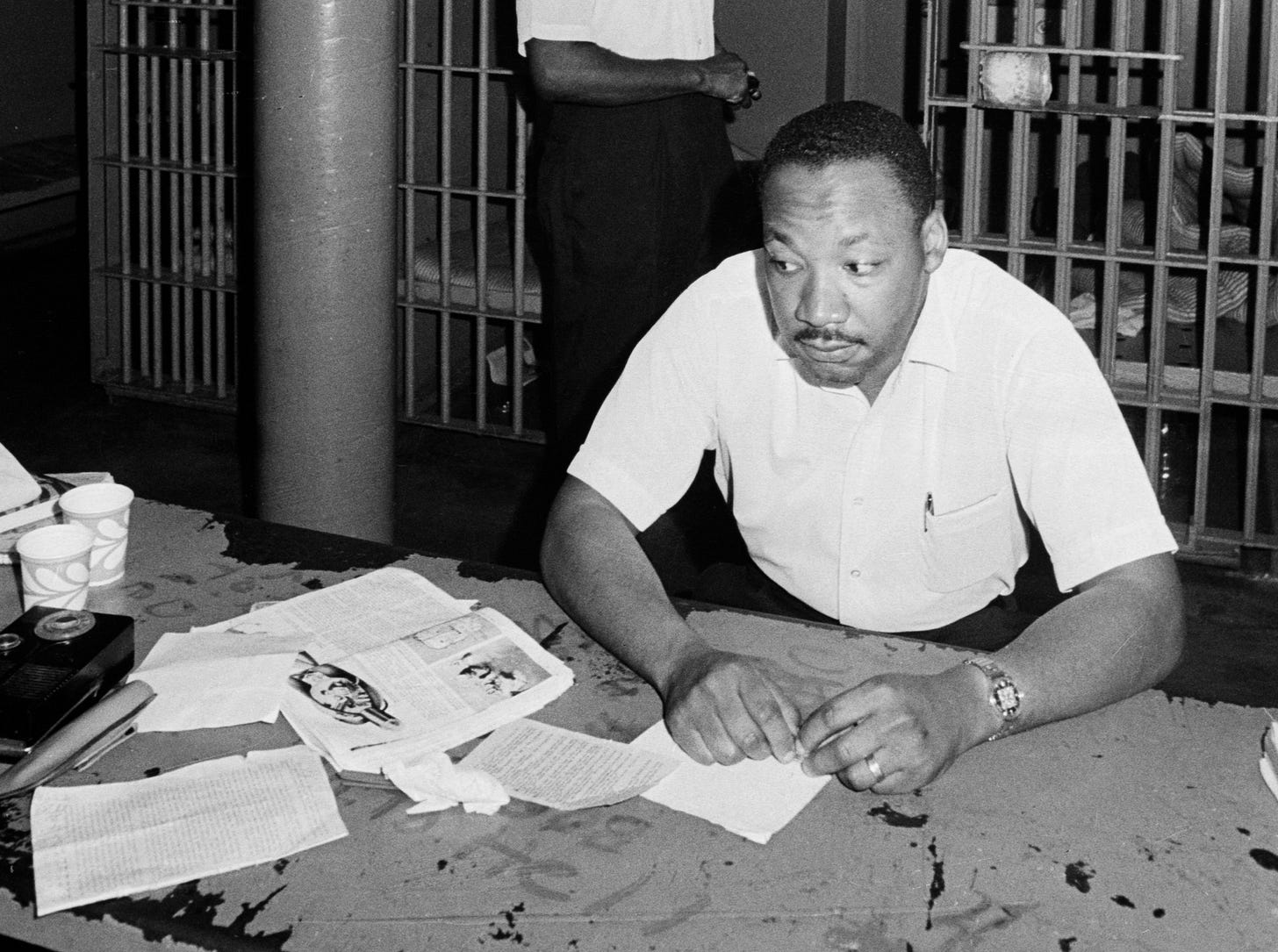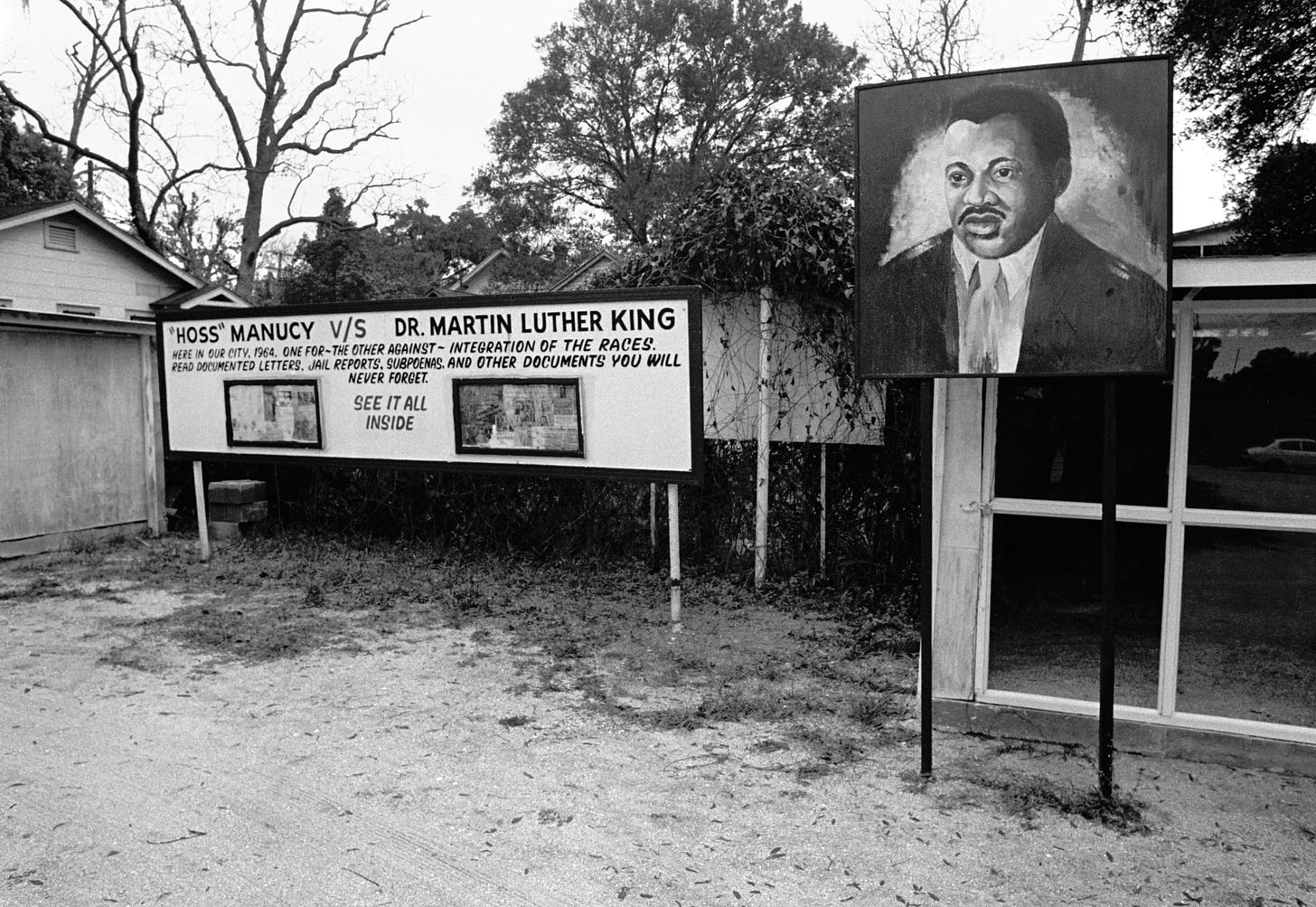The Time That Martin Luther King, Jr. Was Almost Assassinated in St. Augustine, Florida
A little known incident that could have changed history.
In 1964, Martin Luther King, Jr. went to St. Augustine, Florida. Civil rights activists in “The Nation’s Oldest City” had appealed to King for help in their struggle. During his time leading protests in St. Augustine, he was arrested and had the homes where he was staying shot up. “We have worked in some difficult communities,” King said at the time, “but we have never worked in one as lawless as this.”
The attention generated in St. Augustine helped to lead to the passage of the historic Civil Rights Act of 1964. Yet for many years, the city—still full of the same people who had beaten up the peaceful protesters—played down this part of its history. One of the people instrumental in changing that was my dad, David Nolan, an author and historian who spent decades working to prod St. Augustine to promote, preserve, and celebrate its civil rights history. Today, you can find a Freedom Trail and historic markers in St. Augustine detailing the events of 1964, alongside the tourist town’s more omnipresent touting of Spanish conquistadors, imaginary pirates, and ghost tours.
I grew up hearing my dad talk about Martin Luther King’s time in St. Augustine. I thought that I had heard all of his stories long ago. But earlier this year, he casually told me one that left my jaw open—not only because I hadn’t heard it before, but also because it seemed to me that it is important enough, in the context of the historical record, that everyone should know it. In that spirit, I now relay to you: The story of the time that Martin Luther King, Jr. almost got assassinated in St. Augustine, Florida.
My childhood home on the north side of St. Augustine was two blocks away from three different tourist attractions: The Fountain of Youth, where tourists swilled municipal water with magical properties; The Old Jail, a refurbished local jail-turned-hokey tourist magnet; and, seediest of all, The Tragedy in U.S. History Museum (which we always called “The Museum of Tragedy”). This last one was a house that one nutty man named Buddy Hough had turned into an ad hoc museum. It had a wax figure of Lee Harvey Oswald in the front window. It advertised Jayne Mansfield’s death car, as well as the death car of Bonnie and Clyde. It also had random collection of medieval torture equipment out back. It was never quite clear which items were or were not authentic. It was a weird but harmless spot, usually empty, an unpolished outlier on the city’s tourist trail.
As kids, we used to buy Welch’s grape sodas from an ancient Coke machine in front of the Museum of Tragedy. Little did I know how wild the history of the man who ran it was.
My dad heard the following story from Kat Twine, a well known St. Augustinian who, along with her husband, were pillars of the town’s black community, and were intimately involved in the civil rights struggle. My dad dubbed her “the Rosa Parks of St. Augustine.” She is as unimpeachable a source on this topic as there is. And she was an eyewitness to the following incident.
The leader of St. Augustine’s local civil rights protests in the 1960s was Robert Hayling, a black dentist. Dr. Hayling’s office on Bridge Street, in the Lincolnville neighborhood just east of downtown, became a meeting hub for strategy sessions during the civil rights movement. “Martin Luther King was there all the time when he came to St. Augustine,” my dad said. “And of course, it became a very well known site among white racists,” who menaced Hayling and shot up his home.
In the summer of 1964, Kat Twine was in Dr. Hayling’s office, along with Martin Luther King, Jr. Into the office walked Buddy Hough, the owner of the Tragedy in U.S. History Museum. He was holding a pistol. Hough, with his gun, walked up to King.
“I came here today to kill you,” he said. “But I can’t do it. Because when I look at you, I see that you are a god-sent man.”
That local crank, the owner of the strange tourist attraction down the street, held in his hand, for that moment, the course of American history. And then he walked out.
My dad used to give tours of Lincolnville, to spread the word about its history. One year, he told that story on the tour. “An aging white woman came up to me afterwards and said, ‘You know, I was [Buddy Hough’s] nurse in his last days, and he told me that same story,’” my dad said. “It just sent chills down my spine.”
Had Hough pulled the trigger that day, Martin Luther King, Jr. would not have lived the next four years of his life. He would not have led the famous marches in Selma or Chicago. He would not have become an antiwar icon by decrying the Vietnam War. He would not have led the Poor People’s Campaign. He would not have gone to Memphis for the sanitation workers’ strike in 1968. Nobody would know who James Earl Ray was. The Museum of Tragedy in American History would be as famous as the Lorraine Motel. Instead, Buddy Hough walked out, backed down by a god-sent man.
In later years, Hough obtained and put on display the papers of Hoss Manucy, the notorious local racist who led the violent white response to St. Augustine’s civil rights protests. He said, “I put them out there so St. Augustine will never have to go through this kind of hatred again.” When Hough died, my dad tried to buy those papers, for the sake of historic preservation, but got outbid.
The Tragedy in U.S. History Museum closed in the late 1990s. Today, its building is home to a Montessori School. Buddy Hough is remembered, if at all, as just another quirky showman in a town that has produced many of them. Even though I grew up right down the street, I never knew that he almost became an assassin consequential enough to be displayed in his own museum window.
Now I know, and so do you.
Also
You can find a ton of information about St. Augustine’s civil rights history on the site of the Accord Freedom Trail. They are a great organization to donate to, as well.
A few random items: 1) Shay Mirk, a very cool cartoonist and illustrator, has made a zine out of an essay I wrote about abolishing billionaires. You can download the PDF of the zine for free right here and print it out. Zines will never go out of style. 2) I have a new boxing piece in Defector this week about the latest fights in Brooklyn. 3) On Monday, October 27 at 5 p.m., I’ll be talking about labor and, you know, the world with the Kalmanovitz Initiative at Georgetown University. If you’re in DC, stop by. Event info here.
Thank you for reading How Things Work. We’re not just labor, politics, and power—we’re also “interesting historical remembrances.” Truly, independent media is a fountain of surprise. This site exists purely due to the financial support of readers like you. It is free for everyone to read. If you like reading it and want to help us keep going, take a quick second to click the button below and become a paid subscriber today. It’s just $60 for the year, and comes with a large dose of good karma. No matter what, keep coming back.




Absolutely astonishing story! Incredible!
I always tell anyone who will listen to me to read Devil in the Grove by Gilbert King. That book sums up FL and FL policing in such a clear way that it will change you.